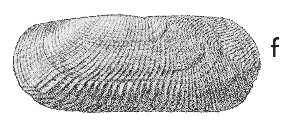
Revised descriptions of New Zealand Cenozoic Mollusca from Beu and Maxwell (1990)

 | Revised descriptions of New Zealand Cenozoic Mollusca from Beu and Maxwell (1990) | 
|
  (Pl. 23f): GS10344, D45/f8483, Calamity Point, Clifden, Altonian (GNS) |
Beu & Maxwell (1990): Chapter 11; p. 218; pl. 23 f.
Synonymy: Solecurtus bensoni Finlay 1924b, p. 471
Classification: Solecurtidae
Description: Size moderate for genus (length 20-36 mm), elongate-elliptical, gaping widely at both ends, beaks situated well forward of centre. Commarginal sculpture of very fine striae and somewhat stronger growth ridges; some shells with broad commarginal colour bands. Other sculpture neither commarginal nor radial, highly variable, consisting of very low, steplike ridges or terraces with steep edge always on posterior margin, absent from small area near anterodorsal margin, but typically present over rest of shell. Ridges slightly wavy, bent back on posterior area, degree of bending typically increasing with distance from umbo. Left valve with a small, subvertical anterior cardinal tooth and a thin posterior cardinal tooth coalescent with nymph plate. Right valve with a narrow, triangular anterior cardinal and a thin, oblique posterior cardinal. Ligament external, extending about a quarter distance to posterior end, nymphs distinctly raised. Pallial sinus linguliform, extending in front of beaks.
Comparison: Solecurtus evolutus (Altonian, Oamaru) is less elongate than S. bensoni, and has its beaks nearer the middle of the shell. S. chattonensis (Duntroonian, Southland) is larger than S. bensoni and has more widely spaced ridges that are less strongly bent on the posterior area. An undescribed species of Solecurtus, differing in its larger size and coarser sculpture, replaces S. bensoni in the lowest Nissen Shellbed ("no. 1") in the Clifden section. Solecurtus has a recorded range of Duntroonian to Kapitean in New Zealand, mostly in shallow-water (inner to mid shelf) assemblages. Although extinct in New Zealand, Solecurtus is widespread in shallow, warm waters elsewhere, including northern New South Wales and Queensland (Lamprell & Whitehead 1992, pl. 57). Modern species are moderately rapid burrowers living in long mucus-lined burrows that bifurcate posteriorly to form separate openings for the inhalent and exhalent siphons (Dworschak 1987).
Distribution: Altonian-Lillburnian; Calamity Point Sandstone, Clifden, Altonian (type), also Otahu Formation, Fouraye Siltstone and Lill Sand, Clifden; New Chum Creek, Karamea district; Pakaurangi Formation, Pakaurangi Point, Kaipara Harbour. Moderately common at type locality, less so at other localities.
Cite this publication as: "A.G. Beu and J.I. Raine (2009). Revised
descriptions of New Zealand Cenozoic Mollusca from Beu and Maxwell (1990). GNS
Science miscellaneous series no. 27."
© GNS Science, 2009
ISBN
978-0-478-19705-1
ISSN 1177-2441
(Included with a PDF facsimile file
copy of New Zealand Geological Survey Paleontological Bulletin 58 in CD version
from: Publications Officer, GNS Science, P.O. Box 30368 Lower Hutt, New
Zealand)